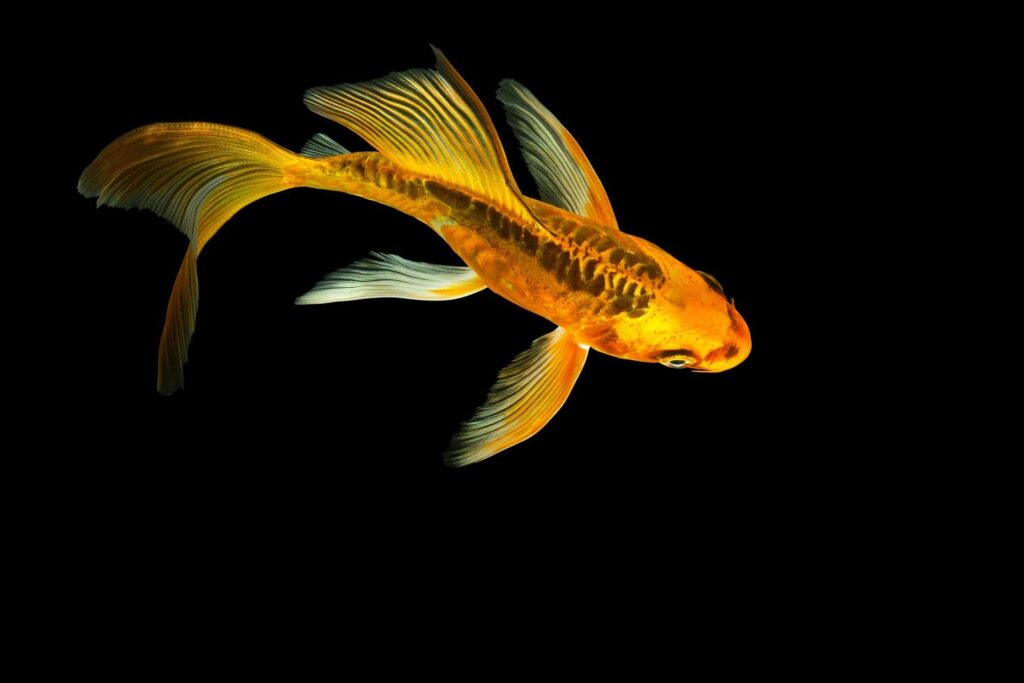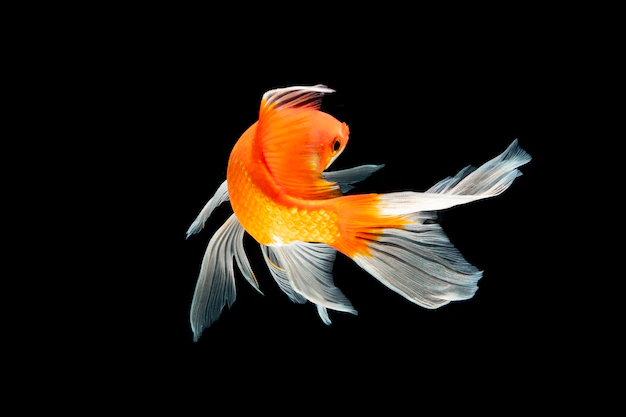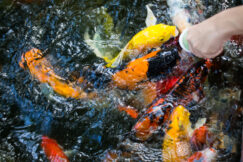A graceful dragon-like butterfly koi is swimming around your pond, trailed by a gorgeous shadow of long fins. Their one-of-a-kind characteristic makes them a delight for pond owners looking for something a little distinctive in their gardens.
What is a butterfly koi?
Butterfly koi, longfin koi, or dragon carp are ornamental fish with elongated finnage. They are known by their scientific name Cynprinus Carpio. Fish are a type of carp known as common carp.
They are a novel koi variety that has yet to gain widespread acceptance among koi purists. Butterfly koi are a hybrid between long-finned Indonesian carp and regular koi and are not strictly koi according to official Japanese criteria. They also don’t have the same body size as conventional koi, but in the correct pond, they can grow 36 to 40 inches long.
Their fins continue to grow longer throughout their lives. As a result, some pond owners enjoy the long, flowing fins. The bodies of butterfly koi are likewise significantly more slender than regular koi, and the barbels on their faces develop slightly longer.
History & origin

Who or where butterfly koi were first grown and created is a point of contention. They were probably developed originally in Japan by Suda Fish Farms, but they were also developed in the United States by Blue Ridge Fish Hatchery during the same period.
While some sources claim that Japanese breeders began cultivating long-finned koi long before the fish arrived in the United States, others claim that the breed rose to prominence in the 1980s after breeders from the Blue Ridge Fish Hatchery in North Carolina took a chance on some long-finned feral carp from New York. They quickly learned that these carp originated in Indonesian waters and were ugly, gangly-finned fish.
Regardless of who was the first to breed these long-finned koi, they grew in popularity due to both breeders’ efforts.
Types of butterfly koi
Butterfly koi come in a wide range of color variations, just like regular koi. Some types are rarer than others, yet they all share the beauty of the butterfly koi’s long fins. This section will briefly overview a few of the most popular butterfly koi variations.
Showa
The Gosanke koi family includes the Showa butterfly koi. The body of the Showa kind of butterfly koi is mostly black, with white regions and red patterning on top. The standard Showa koi was created by crossing a Ki Utsuri with a Kohaku koi and was initially released in 1927.
Sanke
The Goasanke koi family also includes the Sanka butterfly koi, often known as the Taisho Sanshoku. They’re noted for their solid white bodies with red and black spots overlaid on top. The Torazo bloodline is the source of most Sanke koi fish in the koi industry today.
Kohaku
The Kohaku butterfly koi is a solid white koi with red markings on the surface. Kohaku is considered one of the first koi fish to be developed, and it is still one of the most popular varieties today. This variety initially appeared when a black carp with red cheeks was discovered in Japan between 1804 and 1829.
Utsurimono
Red, yellow, and white are the three color variants of the Utsurimono butterfly koi. This koi type is regarded as one of the most attractive. This is reflected in the name, which means “reflections” or “reflecting ones” in English.
Asagi
The Asagi butterfly koi is blue with a reticulated pattern that stretches over the back. Areas of red on the gill plates, abdomen, tail, pectoral fins, and sometimes surrounding the dorsal fin highlight this pattern. This is one of the oldest varieties of koi fish.
Shusui
The Shusui butterfly koi fish is a German koi with blue scaleless skin that substitutes the Asagi koi’s netted appearance. A single row of scales runs down the dorsal line of these creatures. Red markings on the Shusui’s back might extend past the lateral line and onto the fish’s back.
Yamabuki Ogon
The Yamabuki Ogon butterfly koi is the most widely available butterfly koi. It’s brilliant yellow and metallic coloring make it an excellent choice for practically any koi pond.
Butterfly Koi size

Butterfly Koi have a more slender and skinnier body than Japanese Koi. Despite this, they frequently reach the same length as their cousins with short fins. When fully mature, a Butterfly Koi is 12 to 15 inches long.
Although this is the average length for this species, some Butterfly Koi have been known to grow up to three feet in length when cared for in the best possible conditions.
Butterfly Koi’s beauty develops over time as they mature. The longer and better the Koi Butterfly’s fins and whiskers are, and the more graceful they appear while swimming, the older they are.
Butterfly Koi lifespan
When properly cared for, which entails having the optimal water parameters, excellent water quality, and sufficient feed, butterfly koi can live up to 30 years on average. They are strong, sturdy, and disease-resistant since they are a hybrid of traditional Koi and Indonesian carp, which enhances their life span.
Butterfly Koi food and diet
Butterfly Koi have an easy-to-maintain diet. Everything you’d give a traditional Koi can be fed to a traditional Koi.
However, it’s best to give your Butterfly Koi high-quality pellet food with no more than 30% protein to ensure they get enough nutrients and a well-balanced diet to be healthy and flourish.
Live snacks are a favorite of Butterfly Koi. They are ravenous eaters who can consume anything that a human can. You can eat anything from oranges, lettuce, peas, and watermelon to shrimp and algae, so a treat now and again won’t hurt.
Because they are cold-blooded, their digestion is influenced by the temperature outside; the colder it gets, the longer it takes them to digest their meal. This implies they require less food in the winter than in summer.
Pond size requirements
Because the butterfly Koi grows to be giant fish, a pond with a capacity of at least 1000 gallons of water or more is recommended. The butterfly Koi are elegant swimmers that require more space to fulfill their maximum potential growth.
Overstocking your koi pond is not a good idea. When Butterfly Koi fish are overloaded, they panic and battle for oxygen and food. It’s also a good idea to keep the number of butterfly koi in your pond to a minimum.
You should also verify that the pond has good water quality and adequate aeration. A Butterfly Koi will be content and happy in its new home if it has a well-aerated pond with enough aquatic plants and greenery.
Butterfly Koi disease
Butterfly Koi are susceptible to a few diseases, so keep an eye on them to ensure no signs appear. Loss of appetite, clamped fins, open sores, ulcers, white spots, self-isolation, restlessness, and gasping at the pond surface are some signs of sickness in Butterfly Koi. Any of these behaviors could indicate disease and should be addressed as soon as possible.
Bacterial illnesses can also affect them, which should be treated by isolating the affected Butterfly koi in their own tank space. A veterinarian should be consulted for further care, and the fish may be prescribed medication.
Butterfly Koi breeding
The Butterfly Koi breeding procedure is simple, but it does require some interference when selecting the best Koi to mate with and removing the eggs from the communal setting for individual care.
The breeding season for Butterfly Koi begins in late spring when water temperatures reach 68 degrees Fahrenheit. When male Butterfly Koi are ready to breed, they will develop mating tubercles, which appear as white spots on the head and pectoral fins.
Compatible tank mates for Butterfly Koi
Butterfly Koi can be housed in a tank with other non-aggressive fish species with similar water chemistry and lifestyle requirements. If the fish are kept in a regulated tank, Pond Goldfish, Barbs, Catfish, Golden Orfe, Tench, and Pleco are some examples of tank mates suitable for Butterfly Koi.
On the other hand, Butterfly Koi should not be housed in a tank with aggressive fish, little fish, slow-moving species, or fish that do not thrive in external environments. Cichlids, Guppies, Danios, and Fancy Goldfish are a few examples of tank mates incompatible with Butterfly Koi.
How much do Butterfly Koi fish cost?
The production of high-quality Butterfly Koi that are larger and have excellent finnage are highly rare and command the greatest process. When choosing a koi fish, always keep the rules from the preceding section in mind.
Conclusion
Butterfly Koi are mystical fish that glide gently and fluidly with long and flowing fins, adding character and value to your pond. They are calm and tranquil fish that do not require much attention; all you have to do is meet them with balanced food to keep them healthy and happy.




